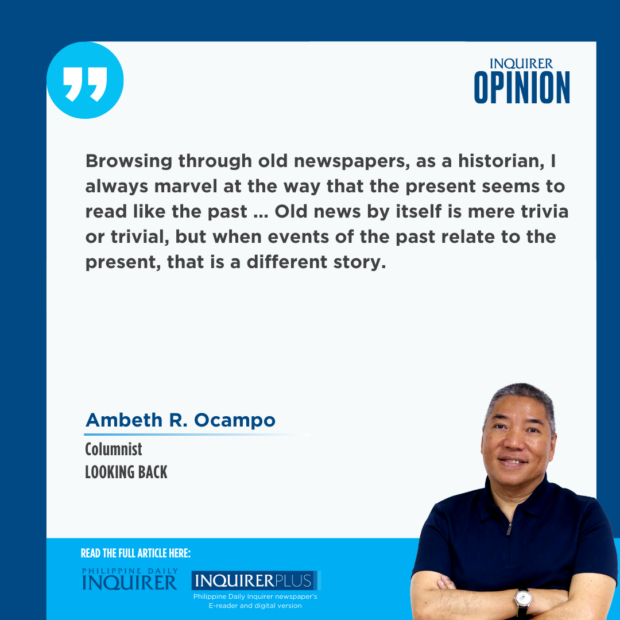
In March 1938, Commonwealth President Manuel Luis Quezon made a surprise visit to the Luneta Police Station and caught the personnel literally “off guard.” To make things worse for the detachment commander, a policeman’s service pistol was left on a bench beside one of the prisoners during the president’s visit. An investigation by Col. Antonio C. Torres, chief of police, showed that the president’s life was not in danger. One of the policemen was changing when the president arrived, his pistol lay on a bench beside a prisoner tasked to clean the room. Common sense, which is not common, dictates that you do not tempt any prisoner outside of a cell or in handcuffs with a gun lying around.
This news item from 1938 reminded me of the security breach around then President Cory Aquino. According to the late Aquilino Pimentel, he accompanied ex-rebels to Malacañang for a photo opportunity with the president who would receive their “surrender.” When all were lined up and cameras were clicking away, one of the journalists suggested having the president receive a gun or rifle from one of the rebels for a more newsworthy photo. Everything stopped and the president asked, “Where do we get a gun?” Then, one of the rebels four people away from Cory innocently put the Presidential Security Group to shame by pulling a pistol out of his pocket saying gleefully: “Oh, we can use my gun.”
It is fortunate that the Philippine Constitution, unlike the United States Constitution, does not give people the constitutional right to bear arms. Our Supreme Court has ruled against the lobbying of guns and ammunition dealers and the PROGUN (Peaceful Responsible Owners of Guns) group stating that owning a firearm is not a property right. To carry and use these require government regulation. In prewar times, regulation went beyond guns and extended to sharp cutting and thrusting weapons in Mindanao. Remember the popular tourist souvenir known as “Weapons of Moroland”?
In 1936, Teofisto Guingona Sr., director of Non-Christian Tribes, prohibited the carrying of barong and kampilan in Cotabato, Lanao, Sulu, and Zamboanga. Only working types with blades measuring less than 15 inches in length were allowed to be carried openly and freely. Otherwise, permits to carry were granted to headmen with the approval of the military provincial commander. Of course, exceptions were granted at the discretion of provincial governors for participants in a celebration or festival. Bowie knives, dirks, kris, kampilan, spears, or other deadly cutting and thrusting weapons were allowed “for purposes of sport only.” Other exceptions were for hunting and protection of their properties.
Browsing through old newspapers, as a historian, I always marvel at the way that the present seems to read like the past. Also from 1938 was this police story: Florencio Diño, 32, of 1171 Antonio Rivera Street was arrested and charged with swindling Mrs. Rosa Soriano de Rosales of P430 cash. Diño was in cahoots with a Persian national who was part of a gypsy gang rounded up for a string of cases: theft, estafa, and short-changing. Diño identified himself to Rosales as a police detective and introduced the Persian as a clairvoyant who could transform worn paper money into fresh, crisp bills. Rosales forked out P430 in old bills to be “rejuvenated” in a closed-hand pressing machine. The pair said they would come back in two days to open the machine and give her back the “new” money minus their service fee. Curious, Rosales didn’t wait two days and peeked into the machine after the pair left and found it empty. Today, people are still scammed but over the phone by voice or text.
Reading old newspapers also gives us an idea about how the character of certain places in the city changes over time. For example, anyone walking in the glitzy Ayala Malls in the Makati Central Business District today will find it hard to imagine the area that was once an empty field, harvested for zacate that was fuel for horses in the age before cars. I associate La Loma today with lechon and the stalls that line the street facing part of the La Loma Cemetery. In 1937, aside from two cemeteries (La Loma and the Manila Chinese Cemetery) there were “two cabarets, and one cockpit, let alone the hundreds of other establishments illicitly run to cater to human concupiscence.” A newspaper editorial dubbed La Loma “a corruptor of public morals … a menace to the health and safety of the people of this city.” A century before the lechon stalls and gentrification, La Loma was a resting place of the dead and for the living, a refuge for hoodlums, gangsters, cochero-thieves, prostitutes, and gangs that operated with impunity, without intervention by the police.
Old news by itself is mere trivia or trivial, but when events of the past relate to the present, that is a different story.
Comments are welcome at aocampo@ateneo.edu